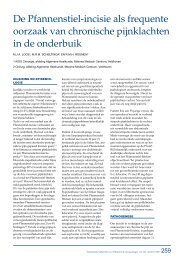QuestionPossible answers1 Could you estimate the average <strong>pain</strong> intensity No <strong>pain</strong>, Mild <strong>pain</strong>, Moderate <strong>pain</strong>,before your operative <strong>inguinal</strong> <strong>pain</strong> treatment? Severe <strong>pain</strong>, Very severe <strong>pain</strong>2 Could you estimate the average <strong>pain</strong> intensity No <strong>pain</strong>, Mild <strong>pain</strong>, Moderate <strong>pain</strong>,directly after your operative <strong>inguinal</strong> <strong>pain</strong> Severe <strong>pain</strong>, Very severe <strong>pain</strong>treatment?3 Could you estimate the average <strong>pain</strong> intensity No <strong>pain</strong>, Mild <strong>pain</strong>, Moderate <strong>pain</strong>,in the treated groin during the past two weeks? Severe <strong>pain</strong>, Very severe <strong>pain</strong>4 Imagine that your preoperative <strong>pain</strong> intensity …………%is set at 100%. What is the percentage <strong>of</strong> <strong>pain</strong>you experienced during the past two weeks?aan de IJssel, the Netherlands) subcutaneously two hours prior to the procedure.By extending the <strong>inguinal</strong> incision several centimetres laterally, access was gained to anon-operated area. The iliohypogastric and/or ilio<strong>inguinal</strong> nerves penetrating theinternal oblique muscles were identified. Any prosthetic material was dissected free <strong>of</strong>these nerves for additional exposure. The genital branch <strong>of</strong> the genit<strong>of</strong>emoral nervewas usually found just posterior to the spermatic cord. Nerves were excised if fibroticencasement or neuroma formation was observed. After peripheral division, proximalnerve ends were cauterized, occasionally ligated under traction, and allowed to retractinto the internal oblique muscle to prevent fibrotic encasement. If nerves were thought‘entrapped’ by preperitoneal mesh, the preperitoneal space was opened by dividing theinternal oblique and transversus abdominis layers. When a displaced bulk <strong>of</strong> meshmaterial was found, parts <strong>of</strong> the bunched up mesh were removed. The sequence <strong>of</strong>technical steps was not standardized, because perioperative findings guided decisionsconcerning nerve resection and mesh removal (‘tailored approach’).5 Did you experience any <strong>of</strong> the following Wound infection, Postoperative‘complications’?haemorrhage, Skin numbnessSkin hypersensitivity, Bulge,Onset <strong>of</strong> other <strong>pain</strong> symptoms6 How is the sensitivity <strong>of</strong> your skin? Normal, No sensitivity, Numb,Hypersensitive, Painful at light touch7 How do you judge your treatment result? Excellent - I am <strong>pain</strong> freeGood - I am almost <strong>pain</strong> freeModerate - Although there is some<strong>pain</strong> reduction, I am still frequentlybothered by <strong>pain</strong> complaintsPoor - The operation had no effectand the <strong>pain</strong> is virtually the sameWorse - The operation has worsened my <strong>pain</strong>8 If you had the choice, would you then opt to Yes, Noreceive the operative treatment again?9 Did you experience any <strong>inguinal</strong> <strong>pain</strong> During sex, During orgasm, Following anpreoperatively during one or moreorgasm, Not appropriate,<strong>of</strong> the following situations?No I did not experience sex-induced <strong>pain</strong>10 If you experienced sex-induced <strong>pain</strong>, did the Yes, I am now totally <strong>pain</strong> freeoperation relieve these <strong>pain</strong> complaints?Yes, there was some improvementNo, these <strong>pain</strong> symptoms are unchangedTable 1 QuestionnaireQuestionnaire and statistical analysisA slightly modified questionnaire based on a recently published review was sent to allpatients in October 2008 (table 1) 13 . Non-responders received two reminders, one bymail and one by phone. Preoperative and current <strong>pain</strong> intensity as measured by a5-point Verbal Rating Scale (and percentages), perceived treatment results, and effect onsexual intercourse-related complaints were scored. To identify possible factors predictingpoor treatment results, a multivariate logistic regression analysis was performed.Treatment results served as the dependent factor (excellent/good/moderate vs. poor/worse), whereas presence <strong>of</strong> recurrent <strong>inguinal</strong> hernia surgery, type <strong>of</strong> initial herniarepair (open non-mesh repair, open or laparoscopic mesh repair), previous <strong>pain</strong> treatmentand presence <strong>of</strong> nerve tissue at histopathologic examination acted as covariatecategorical factors. In order to detect a possible learning curve for the procedure,treatment results were analyzed per treatment year. Results were considered significantfor p-values ≤ 0.05.RESULTSBetween January 2003 and June 2008, 68 patients underwent operative treatment forpostherniorrhaphy <strong>inguinal</strong> <strong>pain</strong>. Fourteen patients were excluded for reasons listed infig 1, leaving 54 patients for analysis (56 groins, bilateral neurectomy in 2 patients).Combined <strong>pain</strong> <strong>syndromes</strong> were present in 6 patients (e.g. nerve entrapment and pubicperiostitis or <strong>pain</strong> from a meshoma). There were 43 males and 11 females with a medianage <strong>of</strong> 50 years (range: 18-88 years). As most patients (n= 41, 75%) were referred from84 Chapter 6Tailored neurectomy for treatment <strong>of</strong> postherniorrhaphy <strong>inguinal</strong> neuralgia 85
Patients with <strong>chronic</strong> postherniorrhaphy groin <strong>pain</strong>who received operative treatment (n=68)Patients eligible for study(questionnaire) (n=54)Response rate to questionnaire91% (n=49)Figure 1 Patient flow chart and response rate to the questionnaire.n (%)Previous groin hernia repair*Open mesh 36 (67)Non-mesh 24 (44)Laparoscopic 10 (19)Previous <strong>pain</strong> therapyGroin exploration (without neurectomy) 12 (22)Nerve blocks 11 (20)Neurectomy 5 (9)Neuropathic <strong>pain</strong> medication 5 (9)TENS** 1 (2)Rhizotomy 1 (2)Orchidectomy 1 (2)Sensory abnormalities***Hypoesthesia 23 (43)Hyperesthesia 14 (26)Normal sensation 8 (15)Allodynia 4 (7)Anaesthesia 1 (2)Trigger point**** 56 (100)Table 2 Characteristics <strong>of</strong> postherniorrhaphy <strong>pain</strong> patients and clinical details (n=54).*Including recurrent hernia repairs, ** Transcutaneous Electric Neuro Stimulation,***missing data in 6 patients, ****in 2 patients bilateral trigger points.Excluded (n=14):- Follow-up period too short (n=6)- Nociceptive <strong>pain</strong> treated bymesh/suture removal (n=8)other hospitals, there was a relatively long median period <strong>of</strong> 2.5 years (range: 3 months-25 years) before patients were evaluated in our clinic. The initial type <strong>of</strong> hernia repair waspredominantly an onlay mesh-based repair, while recurrent repairs were performed in11 patients (20%). Nearly half <strong>of</strong> the patients had received some form <strong>of</strong> previous treatmentfor groin <strong>pain</strong> (table 2). Physical examination revealed abnormalities in sensationincluding hypoesthesia, hyperesthesia, or allodynia, and trigger points in most patients(table 2).Diagnostic nerve blocks were <strong>of</strong>ten used (n=49, 88%) and gave a positive effect in 34patients (76%). Additional imaging modalities, such as Computed Tomography, andMagnetic Resonance Imaging excluded other diagnoses in 12 patients.Perioperative detailsSixty-eight operative procedures were performed in the 5-year study period (table 3).Exploration usually involved examining multiple nerves. The ilio<strong>inguinal</strong> nerve wasresected in over 80% <strong>of</strong> patients followed by the genital branch <strong>of</strong> the genit<strong>of</strong>emoralnerve. To assure an adequate exposure, these procedures were <strong>of</strong>ten supplemented by(partial) mesh removal. Five patients underwent a triple neurectomy. Repeated interventionsdue to persistent <strong>pain</strong> (n=10) or recurrent <strong>pain</strong> symptoms (n=2) were requiredin 12 patients. Postoperative complications were rare. Histology revealed a range <strong>of</strong>abnormalities, such as neuromas and perineural fibrosis. In 8 patients, no histopathologicexamination <strong>of</strong> removed tissue was done.Early follow-up and questionnaireAt early follow-up (





